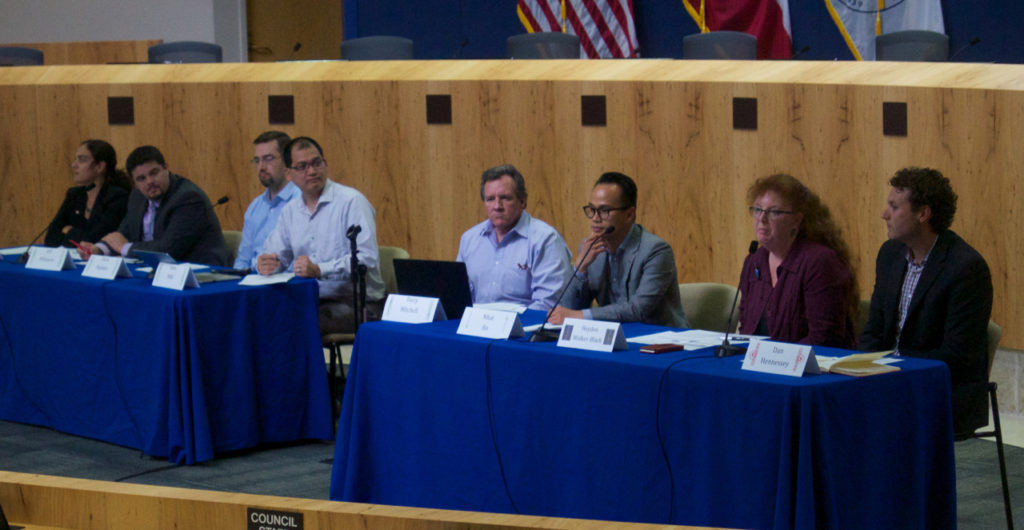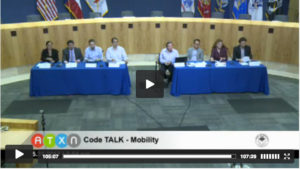
Code Talk Mobility Panel
If there’s any topic that can rival housing affordability as a critical concern for Austin it’s transit. So, it’s no surprise that Council chambers were filled on May 31st as a panel of transportation experts, consultants and city staff members made comments, gave presentations and fielded questions about how CodeNEXT can reduce congestion on the city’s highways and freeways.
The discussion was moderated by Terry Mitchell of Momark Development, who also serves on the boards of Capital Metro and HousingWorks Austin. Mitchell set the tone for the event by pointing out that issues like transportation, housing and the environment are all interrelated and have to be considered together. Mitchell also asked the crowd to keep two points in mind. “One is, change is inevitable,” said Mitchell. The way we used to do it when we were a city of 350 thousand, those days are gone. The second thing I want to point out to you… is that we at a federal level, we at a state level, and we at the local level have not nearly enough money to do all the things we wish we could do.”
The panelists included Dan Hennessey, an engineer with Big Red Dog Engineering, Heyden Black Walker, an urban planner at Black + Vermooy Architecture and Urban Design, Nhat Ho, an engineer at Civilitude, John Miki of Opticos Design, which is overseeing the rewrite of the Land Development Code, Steve Hopkins, a Senior Planner in the City’s Development Services Department, Jeff Whitacre, an Associate with the urban design firm Kimly-Horn and Associates, and Annick Beaudet a manager in the City Transportation Department.
Asked about barriers Austin faces to having a good traffic system, Hennessey pointed to outdated guidelines, standards and data that are restricting the city’s ability to address traffic problems. Black Walker, a staunch advocate for pedestrian safety, said Austin’s roadways were designed to accommodate cars and not other modes of transportation. “We’ve made walking uncomfortable and dangerous,” said Walker. “A third of the people who die every year in traffic are pedestrians.”
The panel then addressed the opportunities the code rewrite presents to improve mobility. They all agreed that this is a valuable opportunity to establish some new priorities. Nhat Ho said, “We have an opportunity with the code to not only shape our transportation system, but also the environment in which we live.”
The audience listened to presentations from consultants and city staff members which included how CodeNEXT can achieve the goals established by Imagine Austin and the relationship between CodeNEXT and Austin’s Strategic Mobility Plan. Then, the panel answered questions that had been submitted by members of the audience. Asked about ways alternative modes of transportation can be incentivized in CodeNEXT, John Miki said simply making accommodations for different modes, such as bicycle riding and walking will spark change. Miki said, “As you can see in Austin where you’ve built the boardwalk along the lake or where you put bike lanes people will choose to use them.” Jeff Whitacre added that the City is offering businesses reduced parking requirements if they locate near public transit, or provide bicycle parking or shower facilities for employees who bike to work.
The lack of affordable housing in Austin has contributed greatly to highway congestion as commuters make their way to and from their suburban homes and their jobs. The question was posed about balancing the needs of commuters living outside the city with people living inside the city. Annick Beaudet said, “I believe that we’re headed with the code, with regards to the multimodal aspect is, what we’re looking at is capturing those short trips off the network. There’s people who drive one to four miles on Mopac or I-35 in the central city who are taking up space from those who absolutely have to drive in from the suburbs,” said Beaudet.
The Code Talk ended with Terry Mitchell once again tying the city’s transportation problems to housing development. “Where I used to do just residential projects, I now look at largely mixed-use projects because I feel this need for our city that we need to mix both jobs and services and housing and put them together,” said Mitchell. “If we plan for that citywide, we’re going to reduce the demand on our major arterials and our highways.”
